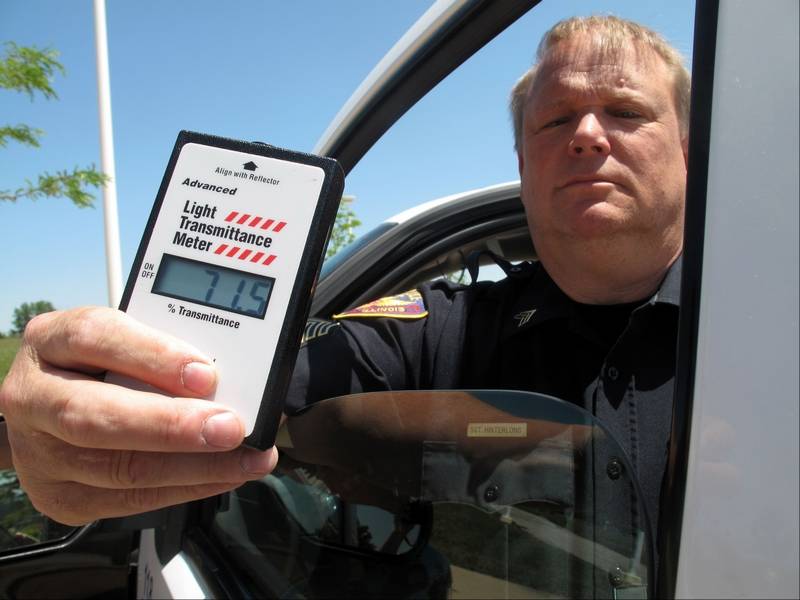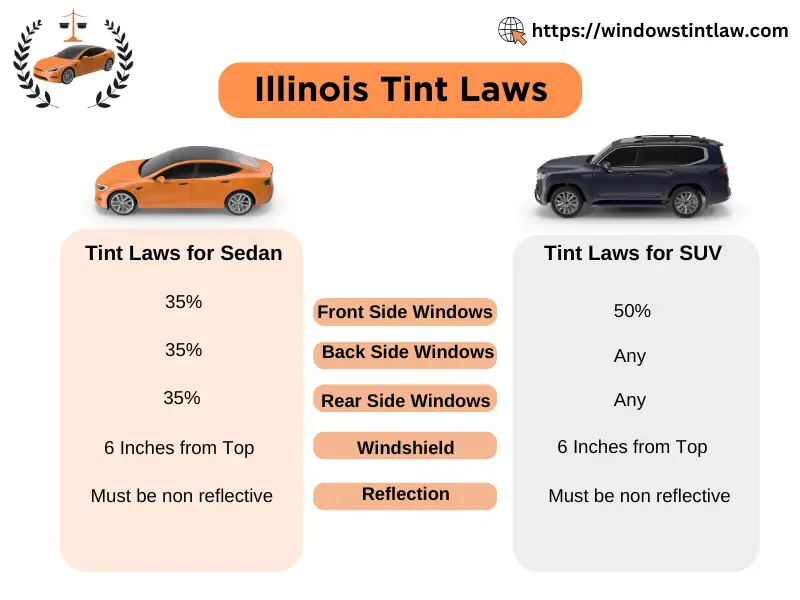As an Amazon Associate, I earn from qualifying purchases
Car window tinting laws in Illinois can be confusing. These laws are essential for drivers to understand.
In Illinois, car window tinting regulations exist to ensure safety and visibility. These laws dictate the level of darkness permitted on vehicle windows. Many drivers choose window tinting for privacy, style, or UV protection. But, not following the specific state guidelines can lead to fines.
Understanding these laws helps avoid trouble and ensures your vehicle stays compliant. This blog post will break down Illinois car window tint laws. We will provide clear information on what is allowed and what is not. Stay informed and keep your car legally tinted.
Introduction To Car Window Tint Laws
Window tinting offers many benefits, like reducing glare and heat inside your car. But each state has its own rules about how dark you can tint your windows. Illinois is no different. Understanding these laws is crucial for every car owner in the state. This ensures you stay within the legal limits and avoid fines.
Importance Of Tinting Regulations
Why do we have tinting laws? These regulations are there for safety reasons. Too dark tints can limit visibility, which might lead to accidents. Police officers also need to see inside vehicles during traffic stops. This is for their safety. So, these laws are important for everyone on the road.
Overview Of Illinois Tint Laws
Illinois has clear rules for window tinting. Here is a simple breakdown:
| Window | Permitted Tint |
|---|---|
| Front Windshield | Non-reflective tint above the AS-1 line |
| Front Side Windows | 35% VLT (Visible Light Transmission) |
| Back Side Windows | Any darkness |
| Rear Window | Any darkness |
Always check the latest local laws before tinting your car windows. Laws can change, and you want to ensure you follow the most recent rules. Also, remember that different vehicles might have different rules.

Credit: www.cartintlaw.com
Legal Tint Percentages
Understanding the legal tint percentages for car windows in Illinois is crucial. Different windows have different rules. Knowing these rules helps you avoid fines and ensures safety on the road.
Front Windows
The front windows of your vehicle must allow more light. Illinois law requires a minimum of 35% visible light transmission (VLT). This means the tint can block up to 65% of light. This rule ensures clear visibility for drivers and law enforcement.
Rear Windows
Rear windows have more lenient tinting rules. You can use any level of darkness for rear windows. This flexibility allows for greater privacy and protection from the sun’s glare. Still, it’s important to maintain safe visibility.
Windshield
The windshield has stricter guidelines. Only the top six inches of the windshield may be tinted. The tint must allow at least 35% of light in. This keeps the driver’s view clear and unobstructed. It’s essential for safety and compliance.
Exemptions And Special Cases
Illinois has specific laws for car window tints, but there are certain exemptions and special cases. Understanding these can help you stay compliant while meeting your needs. Here, we discuss medical exemptions and rules for commercial vehicles.
Medical Exemptions
Illinois allows medical exemptions for car window tinting. This means that individuals with certain medical conditions can apply for an exemption. Here are some important points:
- Qualifying Conditions: Conditions like lupus, photosensitivity, and skin cancer qualify.
- Documentation: You need a certified statement from a physician.
- Application Process: Submit the physician’s statement to the Illinois Secretary of State.
- Approval: Once approved, you will receive a certificate of exemption.
It’s important to carry this certificate in your vehicle at all times. This will help you avoid fines if stopped by law enforcement.
Commercial Vehicles
Commercial vehicles have different rules for window tinting in Illinois. This includes trucks, vans, and other business-related vehicles. Here are the key points:
- Front Side Windows: Must allow more than 50% of light in.
- Back Side Windows: No restrictions on tint darkness.
- Rear Window: Can be any darkness if the vehicle has side mirrors.
These rules help ensure safety while allowing some flexibility for commercial needs. Business owners should ensure their vehicles meet these standards to avoid penalties.
For more detailed information, check the Illinois Vehicle Code or consult with a professional.

Credit: illinoiscarlaws.com
Penalties For Non-compliance
Violating car window tint laws in Illinois can lead to fines and penalties. Drivers may face legal consequences for non-compliance. Ensure your vehicle meets the state’s tint regulations.
Non-compliance with car window tint laws in Illinois can lead to various penalties. These rules are in place for safety and visibility. Understanding the consequences can help you avoid trouble.
Fines And Tickets
If your car windows are too dark, you might get a ticket. The police can stop you and issue a fine. The fine for a first offense can be up to $500. Repeat offenses can lead to higher fines.
Impact On Vehicle Inspection
Non-compliant window tint can affect your vehicle inspection. Your car might fail the inspection if the tint is too dark. You will need to remove or replace the tint to pass. This can be costly and time-consuming. “`
How To Measure Tint Darkness
Understanding how to measure tint darkness on car windows is essential for staying compliant with Illinois laws. This process ensures your car’s window tints meet legal standards, preventing fines and other issues. Let’s explore how you can measure the tint darkness accurately.
Using A Tint Meter
A tint meter is a handy tool for measuring the darkness of your window tint. This device is simple to use and provides accurate readings. Here’s how you can use it:
- First, clean the window to remove any dirt or smudges.
- Next, turn on the tint meter and place it on the window.
- Ensure the meter covers a portion of the window film.
- Read the percentage displayed on the meter.
The percentage indicates the amount of light that passes through the window. Illinois law requires a minimum of 35% VLT (Visible Light Transmission) for the front side windows.
Professional Services
If you are unsure about using a tint meter, consider professional services. Many auto shops offer tint measurement services. They use advanced tools and have the expertise to ensure your window tints comply with state laws. Here’s why you might choose a professional:
- Accurate measurement with certified tools.
- Expert advice on legal standards.
- Time-saving and convenient process.
Professionals can also assist with adjusting the tint if needed, making sure you drive safely and legally in Illinois.

Credit: windowstintlaw.com
Choosing The Right Tint
Choosing the right car window tint involves more than just looks. You need to consider both legal limits and personal style. Illinois has specific laws on window tint. These laws aim to ensure safety and visibility. Picking the right tint can keep you within the law and still give your car that sleek look.
Types Of Tint Films
There are various types of tint films. Dyed window tint is the most affordable. It uses a layer of dye to block sunlight. Metalized tint uses tiny metal particles. This type blocks heat and UV rays. Hybrid tint combines dyed and metalized films. It offers the benefits of both types. Ceramic tint is the most advanced. It blocks heat and UV rays without affecting visibility. Each type has its pros and cons.
Balancing Legal And Aesthetic Preferences
It’s important to balance legal and aesthetic preferences. Illinois law states that front-side windows must allow over 35% of light. Rear windows can be darker. Choosing a legal tint ensures you avoid fines. At the same time, you want your car to look good. A lighter tint on the front and a darker tint on the back can achieve this balance. Consider the type of car you have. Some tints look better on certain models.
Think about your daily driving conditions. If you drive a lot at night, you may want a lighter tint. This helps with visibility. If you drive mostly during the day, a darker tint may be better. This helps block the sun. Always keep safety in mind. The right tint can enhance both the look and function of your car.
Removing Illegal Tint
Removing illegal tint from your car windows is essential to comply with Illinois laws. Whether you want to do it yourself or seek professional help, the following sections will guide you through both options.
Diy Removal Tips
Removing window tint on your own can save money. Start by gathering the right tools. You’ll need a razor blade, a heat gun, and a spray bottle filled with soapy water. Use the heat gun to warm the tint. This softens the adhesive. Slowly peel the tint starting from a corner. If the tint tears, use the razor blade to lift it again. Spray soapy water as you peel. This helps to keep the adhesive from sticking. Once the tint is removed, clean the window with a glass cleaner. This ensures no residue is left behind.
Professional Removal Services
If you prefer a hassle-free option, consider professional removal services. Experts have the right tools and experience. They can remove the tint quickly and efficiently. They also ensure no damage to your windows. Many auto shops in Illinois offer this service. The cost can vary, but it is worth the investment. Ensuring your car is compliant with tint laws avoids future fines.
Staying Updated On Law Changes
Car window tint laws in Illinois can change. Staying updated on these changes is crucial. Ignoring new laws can lead to fines or other penalties. Awareness is key to avoiding trouble.
Following Legislative Updates
Keep an eye on new bills and laws. The Illinois General Assembly website is a good resource. They update their site with new laws regularly. Bookmark the site for quick access. Local news outlets also report on law changes. Subscribe to their updates. Following these sources ensures you stay informed.
Consulting With Professionals
Consulting with a professional can be very helpful. Window tint professionals know current laws. They can advise on legal limits and changes. Regularly visit your local tint shop for updates. They stay updated to offer the best service. Their expertise ensures your tint complies with the law.
Frequently Asked Questions
What Is The Legal Tint Limit In Illinois?
In Illinois, the front side windows must allow more than 35% of light in. The rear side and back windows can be tinted to any darkness.
Are There Medical Exemptions For Window Tint In Illinois?
Yes, Illinois allows medical exemptions for special tint. A certified statement from a licensed physician is required to qualify for the exemption.
Can You Get Pulled Over For Window Tint In Illinois?
Yes, you can be pulled over if your window tint does not comply with Illinois state laws. Ensure your tint adheres to regulations to avoid fines.
How Much Is The Fine For Illegal Tint In Illinois?
The fine for illegal window tinting in Illinois can range from $50 to $500. Repeat offenses may result in higher fines and stricter penalties.
Conclusion
Understanding car window tint laws in Illinois is crucial for all drivers. Compliance ensures safety and avoids fines. Always check local regulations before tinting your windows. Stay informed to keep your vehicle within legal limits. This prevents unnecessary trouble and keeps your driving experience smooth.
Tint your windows responsibly and enjoy the benefits legally. Awareness today saves headaches tomorrow.
As an Amazon Associate, I earn from qualifying purchases


